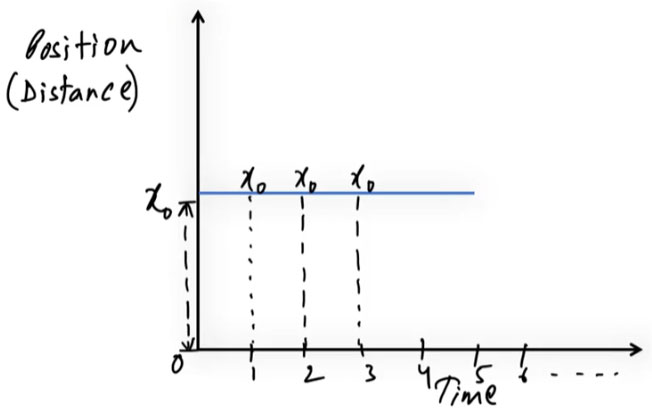Physics and Mathematics
Position Time Graph
The Position–Time (x–t) graph shows how the position (x) of an object changes with time (t). For a stationary object, the position does not change over time — it remains constant.
👉 This is the simplest type of motion graph and helps students understand the meaning of zero velocity.
2. Definition
A stationary object is one that does not change its position with respect to a chosen reference point over time.
Mathematically:
[ x(t) = x_0 ]
where
- [ x(t) ] → Position of the object at time [ t ]
- [ x_0 ] → Constant position of the stationary object
Key Features of the Graph
- The graph is a straight line parallel to the time (t) axis.
- The position remains constant at [ x = x_0 ] for all values of time.
- The slope of the line is zero, which means the velocity is zero:
[ v = \dfrac{dx}{dt} = 0 ]
Graph Description
- X-axis: Time [ t ]
- Y-axis: Position [ x ]
- The horizontal straight line indicates that the position does not change over time.

SI Unit and Dimensional Formula
- Position [ x ]: SI Unit → meter (m), Dimensional Formula → [ [L] ]
- Time [ t ]: SI Unit → second (s), Dimensional Formula → [ [T] ]
- Velocity [ v ]: SI Unit → m/s, Dimensional Formula → [ [L T^{-1}] ]
Practice Questions (With Solutions)
Conceptual Questions
- What is the slope of the position-time graph for a stationary object?
Solution: Zero, because position is constant. - What does the horizontal line in the graph represent?
Solution: The object’s position remains unchanged.
Numerical Questions
- The position of an object is [ x = 5 , \text{m} ] for 10 seconds. Draw the position-time graph and find its velocity.
Solution:Graph: A horizontal straight line at [ x = 5 , \text{m} ] from [ t = 0 ] to [ t = 10 , \text{s} ].Velocity:
[ v = \dfrac{\Delta x}{\Delta t} = \dfrac{5 – 5}{10} = 0 , \text{m/s} ]
FAQs / Common Misconceptions
Q1: Does a horizontal line mean the object is at the origin?
❌ No. It means the position is constant. The line can be above or below the origin depending on the initial position.
Q2: If the line is parallel to the x-axis at [ x = 3 , \text{m} ], what does it mean?
✅ The object stays 3 m away from the reference point and does not move.
Q3: Can the graph for a stationary object be a vertical line?
❌ No. A vertical line would mean the object changes position at the same instant of time, which is not physically possible.adobe